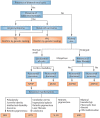Cystic Kidney Diseases From the Adult Nephrologist's Point of View
- PMID: 29623269
- PMCID: PMC5875104
- DOI: 10.3389/fped.2018.00065
Cystic Kidney Diseases From the Adult Nephrologist's Point of View
Abstract
Cystic kidney diseases affect patients of all age groups with the onset spanning from prenatal disease to late adulthood. Autosomal-dominant polycystic kidney disease (ADPKD) is by far the most common renal cystic disease. However, there are various cystic kidney diseases, the onset of which occurs at different times in life and depends on the type of the disease and the causative genes involved. When genetic kidney diseases are discussed in the adult setting this view is usually limited on autosomal-dominant kidney disease, the most frequent genetic disorder causing adult onset ESRD. Other diseases-such as autosomal-recessive polycystic kidney disease-are often being viewed as a disorder only important in pediatric nephrology. However, more recent data has revealed that, despite clear age peaks of onset for each disorder, all of them can also show highly variable phenotypes with classical adult onset genetic diseases being of importance in pediatrics and vice versa. Furthermore, the affected children need to be seen by adult nephrologists in the long term after transition, requiring knowledge on the underlying pediatric disease, potential extrarenal manifestations, and genetic counseling. Consequently, the view on these diseases should be widened on both ends. Close interaction between pediatric and adult nephrology is key to appropriate care of patients suffering from genetic kidney disease to profit from each other's experience.
Keywords: Birt–Hogg–Dubé syndrome; autosomal dominant polycystic kidney disease; autosomal-recessive polycystic kidney disease; genetic kidney disease; nephronophthisis; polycystic kidney diseases; tuberous sclerosis complex; von Hippel–Lindau disease.
Figures


References
Publication types
LinkOut - more resources
Full Text Sources
Other Literature Sources
Molecular Biology Databases

